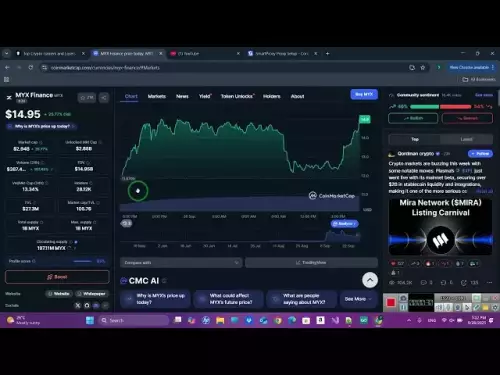-
 bitcoin
bitcoin $109547.008142 USD
0.04% -
 ethereum
ethereum $4011.838726 USD
-0.05% -
 tether
tether $1.000402 USD
-0.01% -
 xrp
xrp $2.798606 USD
0.88% -
 bnb
bnb $970.877944 USD
1.39% -
 solana
solana $202.237275 USD
-0.95% -
 usd-coin
usd-coin $0.999673 USD
0.00% -
 dogecoin
dogecoin $0.229294 USD
-1.15% -
 tron
tron $0.336370 USD
-0.45% -
 cardano
cardano $0.777260 USD
-1.66% -
 hyperliquid
hyperliquid $45.503019 USD
1.73% -
 ethena-usde
ethena-usde $1.000362 USD
0.01% -
 chainlink
chainlink $20.785303 USD
-1.10% -
 avalanche
avalanche $28.755822 USD
-0.11% -
 stellar
stellar $0.358303 USD
-0.48%
How to receive Ethereum on your Trezor device?
Set up your Trezor to receive Ethereum by connecting it to Trezor Suite, selecting ETH, generating a receive address, and verifying it on the device screen for security.
Sep 15, 2025 at 05:00 am

Setting Up Your Trezor Device for Ethereum Reception
1. Connect your Trezor device to your computer using the provided USB cable and ensure the device is powered on. The Trezor Suite interface will launch either automatically or through manual access via the official Trezor website.
2. If this is your first time using the device, follow the setup prompts to create a new wallet. Choose a strong PIN and securely back up your recovery seed on paper, keeping it in a safe location away from digital exposure.
3. Once setup is complete, navigate to the 'Wallets' section within Trezor Suite. The platform supports multiple cryptocurrencies, including Ethereum, and will automatically detect your device.
4. Select Ethereum from the list of available coins. If it is not immediately visible, use the search function or manually add ETH by selecting the appropriate network from the asset list.
5. Confirm that your Trezor firmware is up to date. Older versions may lack support for certain Ethereum-related features or token standards, potentially causing transaction errors or display issues.
Generating an Ethereum Receive Address
1. In Trezor Suite, click on the Ethereum account you wish to use. Each account can generate multiple receive addresses through hierarchical deterministic (HD) wallet derivation.
2. Click the “Receive” button. This will display a new Ethereum address associated with your wallet. This address is unique and cryptographically linked to your private keys, which remain securely stored on the device.
3. The address will appear as a long string of alphanumeric characters starting with “0x”. It will also be represented as a QR code for easy scanning by senders using mobile wallets or exchanges.
4. Verify the address displayed on your Trezor screen by comparing it with the one shown in Trezor Suite. This step is critical to prevent man-in-the-middle attacks or address manipulation by malware.
5. Share the address with the sender through a secure channel. Avoid copying and pasting over unsecured networks or messaging platforms susceptible to hijacking.
Ensuring Security During Ethereum Transactions
1. Always double-check the recipient address on your Trezor’s physical screen before confirming any transaction. Malware can alter clipboard data or web interface displays to redirect funds.
2. Use only the official Trezor Suite application downloaded from trezor.io. Third-party interfaces may mimic the real platform and attempt to steal credentials or seed phrases.
3. Enable passphrase protection if you have set up an advanced access mode. A passphrase adds an extra layer of security, effectively creating a hidden wallet that cannot be accessed without the additional secret.
4. Be cautious when receiving tokens other than ETH. Some ERC-20 tokens may not display correctly on older firmware versions or could interact unexpectedly with the wallet interface.
5. After the sender initiates the transfer, monitor the transaction status through a blockchain explorer like Etherscan. Input your receive address to verify confirmation progress and gas fee details.
Troubleshooting Common Reception Issues
1. If the Ethereum balance does not appear after confirmation, ensure the correct network (Ethereum Mainnet) is selected in Trezor Suite. Other networks like Ethereum Classic or testnets use different ledgers.
2. Clear browser cache or restart Trezor Suite if the interface fails to refresh. Sometimes, delayed synchronization can create the illusion of missing funds.
3. Check that the transaction has sufficient confirmations. Small transfers may take longer due to low gas fees, especially during network congestion.
4. Verify that the sender used the correct address format. Sending funds to a smart contract or non-standard address by mistake can result in permanent loss.
5. Contact Trezor support only through verified channels if the issue persists. Never share your recovery seed or PIN, even with supposed support representatives.
Frequently Asked Questions
Can I receive ERC-20 tokens on my Trezor Ethereum address?Yes, ERC-20 tokens can be sent to the same Ethereum address used for ETH. However, you must manually add the token to Trezor Suite’s interface to view the balance. Navigate to the Ethereum account settings and use the “Add token” option by entering the contract address.
What should I do if I sent ETH to the wrong address?Transactions on the Ethereum blockchain are irreversible. If funds were sent to an incorrect or invalid address, recovery is not possible unless the recipient voluntarily returns them. Always confirm the address on your Trezor screen before finalizing any transaction.
Does Trezor support Ethereum staking?Trezor hardware devices can be used to manage keys for Ethereum staking, but direct staking through Trezor Suite is not currently supported. Users must use external staking platforms while keeping their withdrawal credentials secured on the device.
Why isn’t my Ethereum balance showing up in Trezor Suite?Ensure your device is connected properly and synchronized. Confirm the correct network is selected and that the transaction has enough confirmations. If using a passphrase, make sure it is entered correctly during login, as it generates a different wallet path.
Disclaimer:info@kdj.com
The information provided is not trading advice. kdj.com does not assume any responsibility for any investments made based on the information provided in this article. Cryptocurrencies are highly volatile and it is highly recommended that you invest with caution after thorough research!
If you believe that the content used on this website infringes your copyright, please contact us immediately (info@kdj.com) and we will delete it promptly.
- Ripple, Shiba Inu, and Digitap: The Crypto Landscape in 2025
- 2025-09-28 23:05:12
- Crypto Portfolio Management: Riding the Whale Waves and Finding Gems
- 2025-09-28 22:45:14
- BTC Price Wobbles as Bitcoin ETFs See Inflows, Ethereum ETFs Bleed: What's the Deal?
- 2025-09-28 22:25:17
- DeepSnitch AI: The Meme Coin Alternative with 1000x Potential?
- 2025-09-28 22:45:14
- BlockchainFX, Solana, Dogecoin: Decoding the Crypto Shift
- 2025-09-28 23:05:12
- Crypto's Wild Ride: Dogecoin, AVAX, TRUMP, and the Newcomer MAGACOIN FINANCE
- 2025-09-28 23:10:01
Related knowledge

How do I view smart contract interaction history in Coinbase Wallet?
Sep 24,2025 at 01:36am
Accessing Smart Contract Interaction History in Coinbase Wallet1. Open the Coinbase Wallet application on your mobile device and log in using your cre...

How do I use the token swap feature in Coinbase Wallet?
Sep 24,2025 at 05:00pm
Understanding Token Swaps in Coinbase Wallet1. The token swap feature in Coinbase Wallet enables users to exchange one cryptocurrency for another dire...

How do I participate in governance voting in Coinbase Wallet?
Sep 25,2025 at 01:55pm
Understanding Market Volatility in the Crypto Space1. Cryptocurrency markets are known for their extreme price fluctuations, often driven by sentiment...

How do I set up a custom RPC node in Coinbase Wallet?
Sep 24,2025 at 12:00pm
Understanding Custom RPC Nodes in Coinbase Wallet1. A custom RPC (Remote Procedure Call) node allows users to connect their Coinbase Wallet to a block...

How do I manage multiple assets in Coinbase Wallet?
Sep 23,2025 at 10:00am
Understanding Multi-Asset Support in Coinbase Wallet1. Coinbase Wallet allows users to store a wide variety of digital assets beyond just Bitcoin and ...

How do I connect Coinbase Wallet to a hardware wallet?
Sep 26,2025 at 02:54am
Connecting Coinbase Wallet to a Hardware Device1. Open the Coinbase Wallet app on your mobile device and ensure it is updated to the latest version. N...

How do I view smart contract interaction history in Coinbase Wallet?
Sep 24,2025 at 01:36am
Accessing Smart Contract Interaction History in Coinbase Wallet1. Open the Coinbase Wallet application on your mobile device and log in using your cre...

How do I use the token swap feature in Coinbase Wallet?
Sep 24,2025 at 05:00pm
Understanding Token Swaps in Coinbase Wallet1. The token swap feature in Coinbase Wallet enables users to exchange one cryptocurrency for another dire...

How do I participate in governance voting in Coinbase Wallet?
Sep 25,2025 at 01:55pm
Understanding Market Volatility in the Crypto Space1. Cryptocurrency markets are known for their extreme price fluctuations, often driven by sentiment...

How do I set up a custom RPC node in Coinbase Wallet?
Sep 24,2025 at 12:00pm
Understanding Custom RPC Nodes in Coinbase Wallet1. A custom RPC (Remote Procedure Call) node allows users to connect their Coinbase Wallet to a block...

How do I manage multiple assets in Coinbase Wallet?
Sep 23,2025 at 10:00am
Understanding Multi-Asset Support in Coinbase Wallet1. Coinbase Wallet allows users to store a wide variety of digital assets beyond just Bitcoin and ...

How do I connect Coinbase Wallet to a hardware wallet?
Sep 26,2025 at 02:54am
Connecting Coinbase Wallet to a Hardware Device1. Open the Coinbase Wallet app on your mobile device and ensure it is updated to the latest version. N...
See all articles









































































